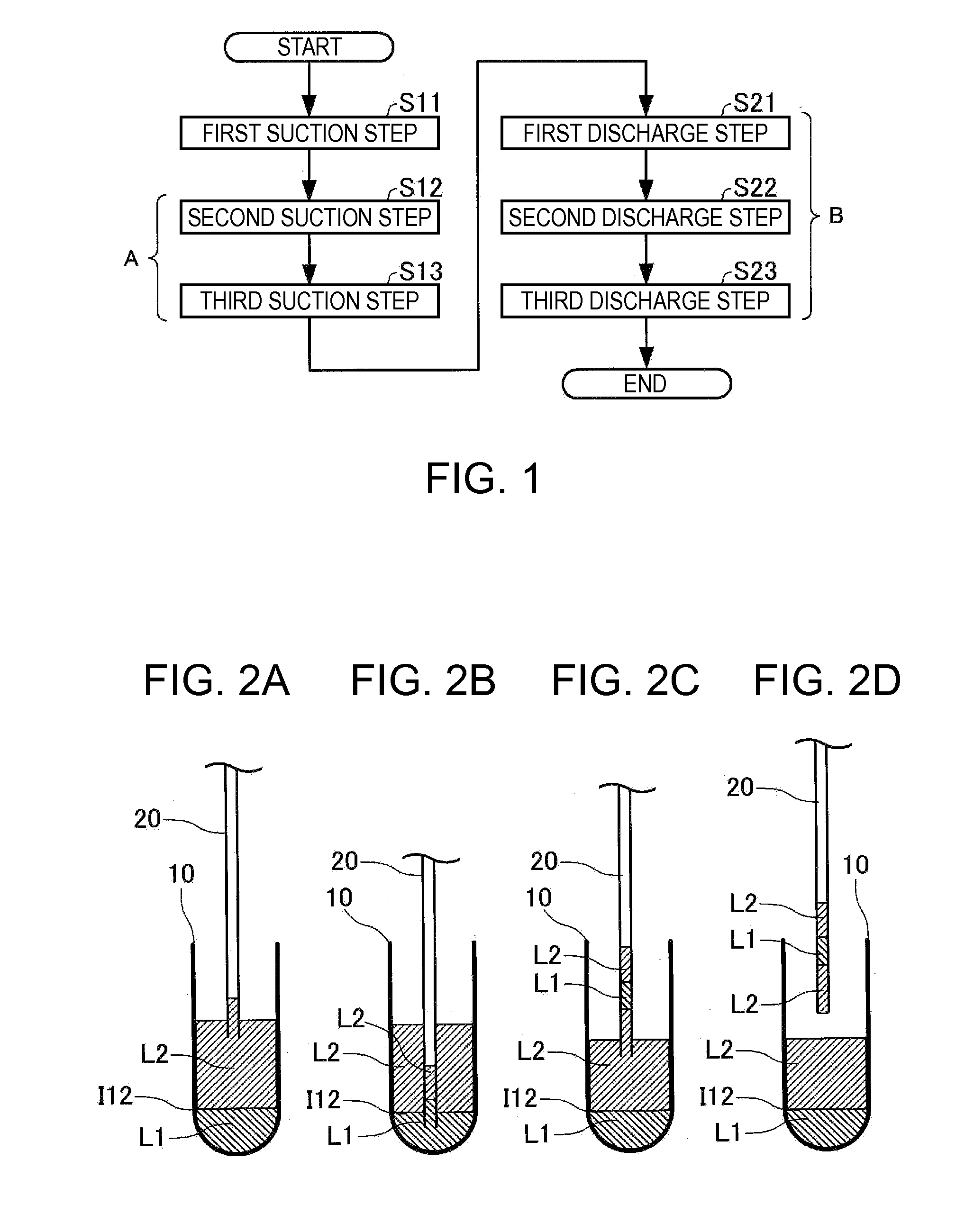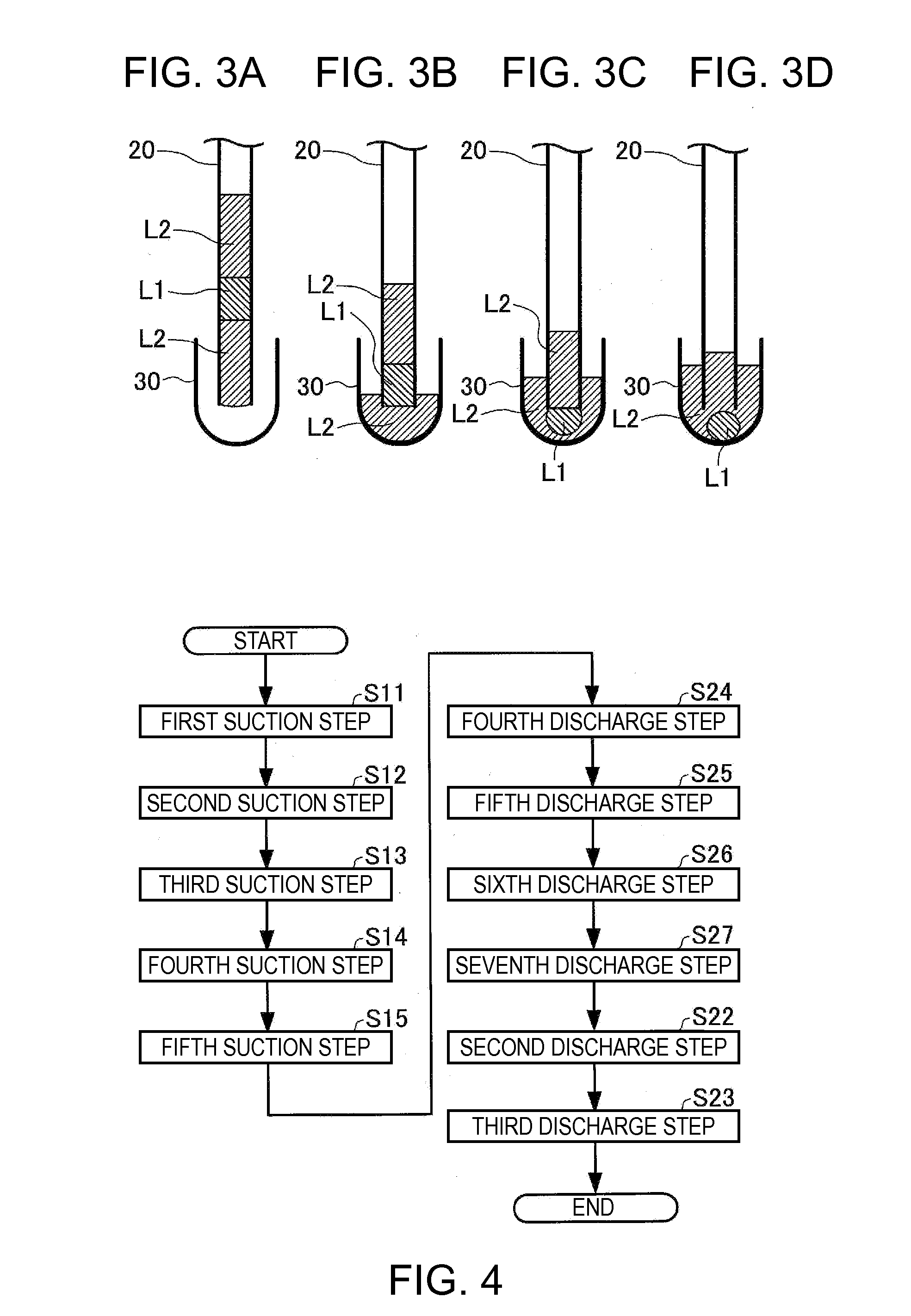Dispensing method
a technology of dispensing method and liquid volume, which is applied in the field of dispensing method, can solve the problems of difficult to contact a gaseous phase (such as air), difficult to handle this volume of liquid with sufficient accuracy, and difficult to achieve accurate dispensing of liquids. , to achieve the effect of smooth shifting within the tube and accurate dispensing of liquids
- Summary
- Abstract
- Description
- Claims
- Application Information
AI Technical Summary
Benefits of technology
Problems solved by technology
Method used
Image
Examples
first embodiment
1. First Embodiment
[0056]A dispensing method according to a first embodiment of the invention is hereinafter described. FIG. 1 is a flowchart showing the flow of the dispensing method in this embodiment. Each of FIGS. 2A through 2D and FIGS. 3A through 3D schematically illustrates apart of the steps performed in the dispensing method according to this embodiment. FIG. 2A schematically illustrates a first suction step in this embodiment. FIG. 2B schematically illustrates a second suction step in this embodiment. FIG. 2C schematically illustrates a third suction step in this embodiment. FIG. 2D schematically illustrates a condition after the third suction step in this embodiment. FIG. 3A schematically illustrates a preparatory condition before a first discharge step in this embodiment. FIG. 3B schematically illustrates the first discharge step in this embodiment. FIG. 3C schematically illustrates a second discharge step in this embodiment. FIG. 3D schematically illustrates a third dis...
second embodiment
2. Second Embodiment
[0108]A dispensing method according to a second embodiment of the invention is hereinafter described. FIG. 4 is a flowchart showing the flow of the dispensing method in this embodiment. Each of FIGS. 5A through 5D schematically illustrates a part of the steps performed in the dispensing method in this embodiment. FIG. 5A schematically illustrates a preparatory condition of a fourth suction step in this embodiment. FIG. 5B schematically illustrates the fourth suction step in this embodiment. FIG. 5C schematically illustrates a fifth suction step in this embodiment. FIG. 5D schematically illustrates a condition of the tube after the fifth suction step.
2.1. Structure
[0109]The dispensing method according to this embodiment is a method for dispensing the first liquid L1 contained in the first vessel 10 which stores the first liquid L1 and the second liquid L2, and a third liquid L3 contained in a third vessel 12 which stores the second liquid L2 and the third liquid L...
third embodiment
3. Third Embodiment
[0144]A dispensing method according to the third embodiment of the invention is hereinafter described. FIG. 6 is a flowchart showing the flow of this dispensing method. Each of FIGS. 7A through 7E and FIGS. 8A and 8B schematically illustrates apart of the steps performed in the dispensing method in this embodiment. FIG. 7A schematically illustrates the fifth suction step in this embodiment. FIGS. 7B and 7C schematically illustrate a mixing step in this embodiment. FIGS. 7D and 7E schematically illustrate a condition after the mixing step in this embodiment. FIG. 8A schematically illustrates an eighth discharge step in this embodiment. FIG. 8B schematically illustrates a tenth discharge step in this embodiment.
3.1. Structure
[0145]The dispersing method in this embodiment is a method for dispersing the first liquid L1 contained in the first vessel 10 which stores the first liquid L1 and the second liquid L2, and the third liquid L3 contained in the third vessel 12 wh...
PUM
| Property | Measurement | Unit |
|---|---|---|
| volume | aaaaa | aaaaa |
| volume | aaaaa | aaaaa |
| volume | aaaaa | aaaaa |
Abstract
Description
Claims
Application Information
 Login to view more
Login to view more - R&D Engineer
- R&D Manager
- IP Professional
- Industry Leading Data Capabilities
- Powerful AI technology
- Patent DNA Extraction
Browse by: Latest US Patents, China's latest patents, Technical Efficacy Thesaurus, Application Domain, Technology Topic.
© 2024 PatSnap. All rights reserved.Legal|Privacy policy|Modern Slavery Act Transparency Statement|Sitemap



